Contribution of improved nitrogen fertilizer use to development of a low carbon economy in China

Summary
The use of nitrogen (N) and other fertilisers has been one of the keys to achieving food security in China. Grain production almost doubled in China between 1980 and 2010, yet total fertiliser use increased more than four-fold in the same period. This disparity is partly due to changes in cropping, with a large increase in the area devoted to horticultural crops (vegetables and fruit trees) that are given large rates of fertiliser, especially N. But it also reflects the extremely high rates of N application given to a wide range of crops, including cereals. There is overwhelming evidence that rates of N applied to many crops in many regions of China are greatly in excess of the rates required to achieve maximum economic yield. These excessively high rates, combined with inappropriate fertiliser management practices such as timing and method of application, have led to very inefficient use of N and considerable losses to water and air with numerous adverse environmental impacts. A key reason for much of the inappropriate fertiliser management is that many farmers are part-time, with more lucrative income from off-farm work. Thus farm operations are given a low priority, with little incentive to change practices if these involve additional costs, or labour, that interferes with the off-farm work. In this article we review the current situation regarding N fertiliser in China, with an emphasis on the reductions in greenhouse gas emissions that are achievable through changes in both manufacturing and agricultural use. We argue that, although technical innovations have a role, these are only likely to be widely adopted in practice if policy changes are implemented to promote changes in fertiliser manufacturing and on the farm. Necessary changes in policy include changes to the subsidy, originally developed to make fertilisers affordable to farmers in the period before rapid economic development in the country. At the farm level, policies to promote greater professionalism in farming through increasing the size of farms will facilitate more rational use of N. This is possible as large numbers of former farmers move to other work in cities; the Chinese government has policy initiatives in this area through changes in land rental arrangements. Another welcome change would be measures to promote more farmer-oriented approaches to the delivery of technical advice such as the farmer field-school approach, and development of a contractor sector for fertiliser application.
Introduction
China has been extremely successful in achieving food security through a set of government-initiated measures introduced over several decades.
For many years there was a de facto policy of aiming at close to 100% self-sufficiency in basic food crops: in 1996 the policy was modified and a target of at least 95% self-sufficiency in grains was formally adopted.
The measures adopted during the last 30-40 years to achieve food security have included provision of new crop cultivars to farmers, installation of infrastructure such as irrigation schemes, subsidies to fertiliser manufacturers to limit the price of fertilisers to farmers, and various subsidies to farmers to enable them to purchase inputs such as fertilisers, pesticides and machinery.
The use of fertilisers, especially nitrogen (N), has been a major factor in achieving food security – so the policies to make it available and affordable have been successful. But there is now overwhelming evidence of N fertiliser being applied at excessive rates and in ways that lead to its inefficient use and large losses to the environment, with a wide range of damaging environmental and economic impacts.
These excessive rates are a major cause of agriculture overtaking industry as the main source of pollution (1), and this is estimated to be causing a reduction in national GDP of about 1%. The situation could be termed an “overshoot”; policies that were entirely appropriate in the past have served their purpose, successfully, but are no longer helpful and are having unintended and perverse consequences.
This paper briefly reviews the evidence for current over-use and misuse of N fertiliser in China and the environmental and economic benefits to be gained from a move to a more rational use. We emphasise the reductions in greenhouse gas (GHG) emissions to be derived from reduced use because this aspect has previously received less attention than has water pollution. We conclude that changes in policy are urgently required if a more rational use of N fertiliser is to be achieved – improved training of farmers is necessary, but is generally insufficient to alter behaviour, especially if not accompanied by appropriate policies and economic measures. A particular requirement is for a change in the current subsidy regime affecting N fertiliser. There are strong moves in China to develop a greener economy, with lower GHG emissions per unit of production, or of economic output, but the large and very cost-effective contribution that is possible from agriculture is often not recognised.
Nitrogen fertiliser use – present situation
Figure 1 shows the increase in total production of grain (wheat, maize, rice) and the use of fertilisers (total of N, P and K) between 1980 and 2010. Grain production increased to 170% of its 1980 level but the corresponding increase in fertilizer use was 438%.
In part this is a reflection of increasingly inefficient use of fertilisers but it also results from a major change in cropping patterns over the period. There has been a large increase in production of horticultural crops (vegetables and fruit), both in open fields and under plastic.
Table 1 shows changes in the amounts of fertiliser (total of N, P and K) applied to different classes of crop over the ten year period, 1998 to 2008. The amount applied to vegetables almost trebled and that to fruit crops doubled; this partly reflects the greatly increased area of these crops and partly the very large rates of fertiliser (especially N) applied to them.
There is a particular issue with N fertiliser being applied at rates in excess of that required to achieve maximum yield. There are numerous examples of this for all major crops in most regions of China. Over-application, and a range of inappropriate management practices, have led to very inefficient use of N fertilizer by crops in China.
Figure 2 shows the partial factor productivity for N (PFPN) of grain crops in China over the period 1980 to 2005. PFPN is the ratio of grain produced to N applied so a larger number represents a more efficient use of N fertiliser. During the 25 year period shown, the value of PFPN decreased by half from 34 kg grain kg-1 N applied when N rates were low in the early 1980s to about 15 kg grain kg-1 N in recent years. For comparison, the PFPN for maize in the USA increased from about 40 to almost 60 kg grain kg-1 N between 1980 and 2000 (2).
Fortunately, there is widespread evidence that reduced application of N fertilizer, often combined with changes in timing or other management factors, can achieve the same crop yields as current excessive applications. In one study, two major cropping systems of great importance to China’s food security were investigated: the rice-wheat system as practiced in the Yangtze River basin in Jiangsu Province and the maize-wheat rotation in the North China Plain. (3).
The authors concluded that current crop yields could be maintained with reductions of 30-60% in N fertilizer applications.
Another study on rice in 20 farms in the Yangtze basin, this time in Zhejiang Province, showed that in one year N applications to rice could be reduced from 300 to 150 kg N ha-1 with no loss of yield (4).
In other years and sites reductions of about 30% were more common. In the North China Plain a study on N fertilisation of winter wheat (5) showed that by basing N applications on measurements of mineral N in soil total applications could be reduced to 55-65 kg N ha-1, with no loss of yield, instead of the farmers’ practice of 300 kg N ha-1. This dramatic result was because of large residues of nitrate in the soil, unused from previous years which are normally ignored, or are lost due to excessive irrigation. Such large savings are unlikely to be sustained indefinitely, but reductions of 30-50% compared to current common practice, as shown in other studies, are considered sustainable in the long term. Management practices such as timing are also important for increasing the efficiency of use of applied N; in the study previously cited (5) it was found that, with current rates of N, crop yields could be doubled compared with farmers’ yields through a set of management changes.
Single year experiments demonstrating that yields are maintained with reduced N application can, correctly, be criticised as being a reflection of nitrate accumulated in the soil over many years and thus not repeatable in future years. However, long-term experiments clearly show that high yields can be sustained with N rates that are significantly lower than current common practice. For example, at one site in Henan Province, in the North China Plain (part of an 8-site national network of experiments), yields of wheat in the wheat-maize double crop rotation were sustained at 6-8 t ha-1for 15 years with an annual N application of 165 kg N ha-1. This rate is far lower than commonly observed in the region, that are well in excess of 200 kg N ha (6).
Table 2 (from Norse et al., (7)) summarises results for a range of crops in various regions of China which demonstrate that substantial savings of N fertiliser can be made. Not only is crop yield not decreased, there is often a modest yield increase. A small increase in yield compared to crops receiving excessive N fertilizer is not unexpected because it well known that crops over-supplied with N are more susceptible to pests and diseases (8), so a more rational N management should lead to decreased use of pesticides with wider benefits for the environment and human health, in addition tofinancial gain for the farmer. Crops over-supplied with N can also be more prone to “lodging” where crops fall over, due to weakness of the stems, making harvesting more difficult, and so leading to loss of grain. In addition, research at China Agricultural University has shown than maize plants receiving a super-optimal amount of N fertiliser have a smaller root system than that of correctly fertilised plants (Figure 3).
Over-use of N fertiliser in China has serious impacts on land, water and air at the local, regional and global level.
Soil acidification has doubled over the past 30 years, to which N fertilizer has contributed about 60% (9). Much of the acidification stems from the high inputs of ammonium-based N fertilizer such as urea and the uptake and removal of base cations rather than from acid rain.
However, in view of the rapid increase in animal numbers in recent years, ammonia emissions from manure and other livestock wastes may become of increasing importance. The crop yield and food security impacts of acidification include suppression of rhizobial activity and reduced availability of micro-nutrients, in addition to direct impacts of acidification on crop growth. The outcome is a threat to the sustainability of Chinese agriculture.
In the case of surface waters, nitrate entering rivers and lakes (together with phosphate, often derived from poor management of manure) leads to algal blooms, the growth of water weeds and widespread eutrophication. More than 50% of China’s major lakes are now eutrophic and for most of them the situation is getting worse (10).
The incidence of algal blooms has increased several-fold since the 1990s and agriculture is responsible for 25-80% of N inputs to major rivers which, in turn, are damaging to fisheries and so damage food security in a different sector. With both surface waters and ground waters, nitrate not taken up by crops leads to high concentrations in water used for drinking, which often exceed WHO guidelines for drinking water. Algal blooms themselves also pose a health threat to animals and humans due to production of potent toxins by the cyanobacteria (also known as blue-green algae) that comprise the blooms. The impact can be direct through drinking of the water (11, 12) or through the food chain, especially via shellfish (13) and the occurrence of cyanobacterial blooms is likely to increase under the influence of climate change (14).
Finally there is the important impact on air quality, particularly the emissions of ammonia that lead to particulate formation with resulting implications for human health (15), eutrophication of natural and semi-natural aquatic and terrestrial systems, soil acidification as described above and to the greenhouse gas emissions examined in the next section.
Figure 5a illustrates the situation regarding high rates of N fertiliser applied to horticultural crops. The data are from a survey of farmers growing tomatoes under plastic in so-called “sunlight greenhouses” of the suburbs of Xi’an city in northwest China (16).
The greenhouse structure is covered with plastic for part of the year to provide a protected environment and increased temperature for growing a range of horticultural crops including tomatoes, cucumbers, courgettes (zucchini), aubergines (egg plant) and peppers that have a high value. The plastic is removed from the structures during summer, when rainfall is relatively high and the higher temperature is not needed. Salts accumulated in the soil are leached out of the topsoil during this period.
Of the 116 greenhouses surveyed in an area near Xi’an city, 65% of farmers were applying in excess of 400 kg N ha-1 with a quarter applying >800 kg N ha-1. These rates are extremely high by international standards and were in addition to large annual manure applications estimated to be supplying almost 1000 kg N ha-1. Not surprisingly these management practices led to very large residues of nitrate in soil. More than 60% of sites where soil was analysed contained >350 kg N ha-1 as nitrate-N in the soil to a depth of 1m (Figure 5b). The issue of inefficient use of nutrients from manure has recently been reviewed and proposals made for addressing the problem (17), as manure applications are generally ignored when farmers make decisions on application rates of fertilizer.
Of the 116 greenhouses surveyed in an area near Xi’an city, 65% of farmers were applying in excess of 400 kg N ha-1 with a quarter applying >800 kg N ha-1. These rates are extremely high by international standards and were in addition to large annual manure applications estimated to be supplying almost 1000 kg N ha-1. Not surprisingly these management practices led to very large residues of nitrate in soil. More than 60% of sites where soil was analysed contained >350 kg N ha-1 as nitrate-N in the soil to a depth of 1m (Figure 5b). The issue of inefficient use of nutrients from manure has recently been reviewed and proposals made for addressing the problem (17), as manure applications are generally ignored when farmers make decisions on application rates of fertilizer.
Greenhouse gas emission associated with nitrogen fertiliser
Nitrogen fertiliser inevitably has a large greenhouse gas footprint with emissions from the following sources:
1. Carbon dioxide (CO2) emitted during manufacture, especially from the ammonia production stage using the Haber-Bosch process because this requires a large amount of energy to achieve the necessary high temperature and pressure. The energy is provided largely by fossil fuels, usually natural gas or coal. In China coal is the dominant energy source.
2. Emissions of nitrous oxide (N2O) when N fertiliser is applied to soil. Typically the quantity evolved is small, 1% or less of the N applied, but N2O is a very powerful greenhouse gas; each molecule is almost 300 times more powerful in global warming than a molecule of CO2, so even small emissions have large impacts. Emissions of N2O from the field where N is applied are termed “direct emissions”. Emission can vary widely according to climate, soil type and environmental factors. The gas can be produced from two separate processes in soil, nitrification and denitrification. Nitrification is the conversion of ammonium to nitrate and is a dominant process in most soils except those that are water-logged (as in flooded rice cultivation), or in soils that are very acid. Denitrification is the reduction of nitrate to a mixture of N2O and nitrogen gas, normally in soils under wet conditions in which oxygen is limiting. It is often the main source of N2O from soils, but in the dry conditions of north China there is evidence that nitrification is the major pathway (18, 19).
3. “Indirect emissions” of N2O. These arise from transformations of N that has moved from the site of fertiliser application. For example, nitrate leached from surface soil to deeper layers or to waterways can be denitrified later. Ammonia volatilised from the soil surface after applying urea is redeposited onto soil and water elsewhere and undergoes nitrification and denitrification.
The IPCC derived an average value of 1% of N applied for the direct emission of N2O at the site of fertiliser or manure application, based on a review of world literature (20). This is termed the “emission factor”, EF. Later reviews (21, 22) have suggested an EF value that takes into account total N2O emissions (direct + indirect) in the range 2-5% of applied N.
Widely accepted values for the total greenhouse gas impact of N fertilisers, combining emissions from both manufacture (under European conditions) and agricultural use are 10.5 kg CO2-equivalent per kg N in urea and a corresponding figure of 8.4 for ammonium nitrate (23). A clear implication of this large value is that it is essential to use N fertiliser efficiently, so that emissions are no larger than absolutely necessary.
Some might argue that a strategy of eliminating all use of N fertiliser would be an effective way of decreasing emissions from agriculture, but this would have a devastating impact on global food security. One estimate (24) is that agricultural systems using no chemical fertilisers could, on optimistic assumptions, feed only 4.2 billion people or 60% of the current world population and less than 50% of the population expected by 2050. The concept of “yield-scaled N2O emissions” has been introduced as a way of expressing the N2O efficiency of a cropping system (25).
A global meta-analysis of non-leguminous annual crops showed that N2O emissions expressed as a proportion of crop N uptake (this being used as a proxy for yields across the diverse crops included) were at a minimum at N fertiliser application rates of approximately 180–190 kg N ha-1 and emissions increased sharply after that – for example 3-fold greater for applications rates > 300 kg N ha-1 (25).
N applications that are very low or near zero give increased values for yield-scaled N2O emission because yield is low. The N application rate giving a minimum value of yield-scaled N2O emission was often about the same rate as recommended for maximum economic yield and there was a negative relationship between N use efficiency and yield-scaled N2O emissions. These findings further emphasise the importance of aiming at rational N fertiliser rates as a means of decreasing GHG emissions – but they do not lend support to the idea of eliminating N fertiliser. And even where fertiliser can be replaced by manures or biologically fixed N, N2O emissions still occur (22. 21, 22).
In a recent study by Zhang et al. (26) a life cycle approach was taken to quantify the GHG emissions associated with N fertiliser in China; the results are summarised in Table 3.
The total GHG emission associated with N fertiliser (both manufacture and use) was estimated at 452 Mt CO2-equivalent in 2010, representing 7% of emissions from the entire Chinese economy (26).
Emissions per kg of N fertiliser manufactured and used in China (13.5 kg CO2-equivalent kg-1 N) are higher than corresponding values from elsewhere in the world such as Europe (10.5 kg CO2-equivalent kg-1 for urea-N) for two main reasons. First, coal is the dominant source of energy used in N fertiliser manufacture in China, accounting for 86% of energy use (26). CO2 emissions per unit of energy are greater for coal than for natural gas which is the main source of energy for fertiliser manufacture in Europe and most other regions. In addition to CO2 emitted from the fertiliser plant, the life cycle approach means that the significant methane emissions from the mining of coal should also be included in the accounting. Second, 64% of fertiliser manufacture in China occurs in small plants using old technology (26); for any energy source (coal, oil or natural gas) these plants are less efficient and give larger emissions per unit of N fertiliser produced than larger plants utilising modern technology.
The total GHG emission associated with N fertiliser (both manufacture and use) was estimated at 452 Mt CO2-equivalent in 2010, representing 7% of emissions from the entire Chinese economy (26).
Emissions per kg of N fertiliser manufactured and used in China (13.5 kg CO2-equivalent kg-1 N) are higher than corresponding values from elsewhere in the world such as Europe (10.5 kg CO2-equivalent kg-1 for urea-N) for two main reasons. First, coal is the dominant source of energy used in N fertiliser manufacture in China, accounting for 86% of energy use (26). CO2 emissions per unit of energy are greater for coal than for natural gas which is the main source of energy for fertiliser manufacture in Europe and most other regions. In addition to CO2 emitted from the fertiliser plant, the life cycle approach means that the significant methane emissions from the mining of coal should also be included in the accounting. Second, 64% of fertiliser manufacture in China occurs in small plants using old technology (26); for any energy source (coal, oil or natural gas) these plants are less efficient and give larger emissions per unit of N fertiliser produced than larger plants utilising modern technology.
Options for decreasing GHG emissions connected with N fertilisers in China
Fertiliser manufacture
When seeking to identify opportunities for decreasing GHG emissions from agriculture, especially those associated with N fertiliser, it is common to focus solely on management practices at farm level.
Whilst these are extremely important, the results in Table 3 show clearly that it is also appropriate to consider emissions at the manufacturing stage; in China these account for over 60% of the total emissions from the N fertiliser chain (or 38% if methane from coal mining is excluded). A complete switch from coal to natural gas is not a practical option because China has large reserves of coal but a shortage of domestically sourced natural gas. Consequently changes in the fertiliser manufacturing sector will have to focus on the following:
1. Phasing out small factories which may often cause local air pollution with negative impacts on human health as well as being large GHG emitters.
2. Upgrading technology in existing larger factories.
3. Consider installation of “carbon capture and storage” (CCS) at the largest coal fired factories.
All of these measures will require government action in the form of changes to subsidies (27), including removal of support for small scale plants and incentives to upgrade others, but the potential impact is considerable. A set of scenarios were constructed in the study of Zhang et al. (27) to explore the decreases possible by 2020 and 2030 compared to “business as usual” (scenario 1) in which it was assumed that N fertiliser use would continue to increase in line with projected population increase. This showed that even without improvements in N use at farm level, improvements in the efficiency of the N fertiliser manufacturing process alone (scenario 2), could decrease GHG emissions by 20-30% compared to “business as usual” (Figure 6; these values did not assume major infrastructure installations such as CCS). Even if only a fraction of these GHG savings can be achieved, due to practical constraints, the analysis demonstrates that considerable savings, which are often overlooked, are potentially possible from fertiliser manufacture in China. Additional issues regarding the present subsidy regime are discussed later.
Technical approaches to improve fertiliser management at farm level
Research in China has identified a range of management practices at farm level that would increase the efficiency of use of N fertiliser and/or decrease N losses to the environment (27). These include the following:
n Adjust N application rate to a realistic assessment of crop needs, based on previous yields and taking account of the likely supply of N from soil. The latter includes N mineralised during the cropping season, residual nitrate in the soil profile andN from previous manure applications. As discussed above, there is a vast body of data showing that very significant savings of N can be made with no loss of crop yield – and in some cases small yield increases.
n Adopt sub-surface application of N fertiliser because surface application of urea, which is currently normal practice, frequently leads to large N losses to the atmosphere as ammonia. In one experiment conducted by China Agricultural University, this application method decreased ammonia losses at the time of urea application from 27% to 8%.
n In many situations it may be possible to alter the timing of N fertiliser application such that a greater proportion is given during the main growth period instead of at sowing, or transplanting in the case of transplanted paddy rice.
n Where farmers consider it impractical to adjust the timing of N application (often due to labour constraints at mid-season because of off-farm work use of either slow release forms of N fertiliser or forms containing inhibitors of either nitrification or urease activity in soil. (28, 29).
• In regions where soil and environmental conditions lead to significant emission of N2O through nitrification in soil use nitrate-based fertiliser instead of urea.
• Improve management of animal manures and other organic inputs such as residues from anaerobic digestion (the process used for producing biogas) at all stages in order to decrease N losses and maximise recovery of manure-derived N by crops (17). Taking account of manure-derived N, decreasing fertiliser N application accordingly, is especially important where vegetable crops or fruit trees are grown, as these tend to receive large doses of manure. In regions where there is an excessive quantity of manure due to large animal numbers promote production of organic fertiliser products using aerobic composting and transport these to other regions as a partial substitute for inorganic fertilisers. Because of the cost of the composting process, this requires government subsidies to make it viable.
• Where irrigation is used, adopt “fertigation” in which nutrients are dissolved in irrigation water and delivered to crops during the growing period as this can greatly increase the efficiency of crop utilisation of nutrients. The practice is already used by some farmers growing horticultural crop under plastic but there is a need for greatly improved delivery of advice to ensure that the maximum benefit is obtained. There are also opportunities for extending the practice to irrigated crops grown in open fields, though additional engineering innovation would be required together with delivery of appropriate technical advice.
n In regions where soil and environmental conditions lead to significant emission of N2O through nitrification in soil use nitrate-based fertiliser instead of urea.
n Improve management of animal manures and other organic inputs such as residues from anaerobic digestion (the process used for producing biogas) at all stages in order to decrease N losses and maximise recovery of manure-derived N by crops (17). Taking account of manure-derived N, decreasing fertiliser N application accordingly, is especially important where vegetable crops or fruit trees are grown, as these tend to receive large doses of manure. In regions where there is an excessive quantity of manure due to large animal numbers promote production of organic fertiliser products using aerobic composting and transport these to other regions as a partial substitute for inorganic fertilisers. Because of the cost of the composting process, this requires government subsidies to make it viable.
n Where irrigation is used, adopt “fertigation” in which nutrients are dissolved in irrigation water and delivered to crops during the growing period as this can greatly increase the efficiency of crop utilisation of nutrients. The practice is already used by some farmers growing horticultural crop under plastic but there is a need for greatly improved delivery of advice to ensure that the maximum benefit is obtained. There are also opportunities for extending the practice to irrigated crops grown in open fields, though additional engineering innovation would be required together with delivery of appropriate technical advice.
Innovations necessary to facilitate changes in N fertiliser management
The benefit of many of the changes in N fertiliser management listed above has been known for many years and the changes have been proposed by researchers – yet very few have been adopted by farmers and, in the main, the situation of over-use, mis-use and inefficient use of N fertiliser in China has become progressively worse. Why?
We suggest three sets of key changes that are required if the management of N fertiliser is to improve significantly:
1. Radical changes in the way that information is communicated to farmers.
2. Changes in Government policies relating to subsidies for the manufacture and use of N fertiliser.
3. Measures to increase farm size and professionalism of farmers.
We consider that the second two by far the more significant but we consider each in turn.
Communication of fertiliser management information to farmers
It is often stated in China that the key to improving fertiliser management is to improve the delivery of technical advice to farmers. We consider this to be partially true, but certainly not the full answer. China has a large and established national extension system and in the past it has been effective in assisting farmers. But in recent years, for a range of organisational reasons, it has become ineffective: the reasons have been documented in detail elsewhere (30). It is now understood that extension messages delivered in the traditional mode of “expert tells farmer” are often ineffective. For example, a study based on household data collected from 813 maize farmers in Shandong Province showed that while training on rational fertiliser use (termed: integrated nutrient management, INM) could lead to some reduction in farmers' rates of N fertilizer application, training alone was not sufficient to change practices significantly and farmers only partially adopted the recommended INM (31, 32).
An alternative model is the farmer field school in which “farmer tells farmer”, albeit facilitated by an “expert” or advisory agent. Evidence from around the world, as well as in China, demonstrates that this can be more effective. Although it has been applied in China with respect to pesticide use, as yet it has been little used for fertiliser management. Identifying early adopters and innovators would be key to adoption of these techniques.
Changes in government policies regarding subsidies affecting fertiliser manufacture and use
Subsidies to keep down the cost of fertilisers were introduced to make these vital inputs affordable for small farmers. This policy has clearly succeeded and is no longer necessary. We propose that the general subsidy on fertilisers be removed and replaced by more targeted payments that are relevant to the current situation (10, 27).
A major and positive innovation would be a scheme to promote the role of contractors in applying fertilizer. Virtually all the technical innovations discussed above have either an economic cost (e.g. equipment for sub-surface application of urea), or require additional labour for applying N during the course of the growing season. Because so many farmers are engaged in off-farm work, that is usually far more lucrative than the income from farming a small area, they have no incentive to adopt practices that increase efficiency of N use. Reorganising subsidies such that a farmer had a payment for the use of a contractor, instead of for the cost of fertiliser, could make a major contribution to the improved management of N and other nutrients.
It would be worthwhile for a contractor to purchase machinery for sub-surface fertilizer application whereas it is not so for an individual small farmer. And a contractor specialising in this work would be able to make timely applications, unhampered by labour shortages at key times, as often occurs for the part-time small farmers. There are already agricultural contractors operating in China, often using small combine harvesters and in some cases applying pesticides, so the extension to fertiliser application is not unreasonable – provided the policy and subsidy environment is arranged specifically to facilitate and promote the change.
A similar approach could be extremely useful in promoting the efficient use of nutrients in manure, in terms of transportation and mechanised spreading (17). It would need to be cost-neutral for the farmer and ideally be attractive through a specific payment, at least initially. In practice contractors (termed “professional service providers” in China) are usually innovative farmers who decide to specialise in a specific type of work to increase their income.
A further advantage of promoting this contractor sector is that it represents a cadre of more professionally skilled agricultural operators. They are more likely to be influenced by training programmes than the part-time farmers, who have off-farm priorities.
Also, because their numbers would be smaller than the total of all farmers, the task of delivering relevant technical training is more tractable. However, there are challenges to this approach. For example, it is essential that a farmer has confidence in his or her contractor and trusts their judgment and honesty.
Monitoring the performance of contractors is difficult under current conditions in China: development of
certification or accreditation schemes will be an important development, possibly learning from the FACTS scheme for training and accreditation of fertilizer advisers in the UK which has backing from government agencies, fertiliser industry and farmers organisations (33).
Measures to increase farm size and farmer professionalism
The importance of off-farm work for farmers presents challenges to good agricultural practice, as discussed above.
But it also presents opportunities through the possibility of those wishing to concentrate on other work renting their land to neighbours who wish to specialise in farming. (In China it is a matter of land rental rather than sale because all land is owned the state). This trend leads to a gradual increase in farm size, termed “land consolidation”. It has been occurring for some years in China, initially through informal arrangements but later with official encouragement.
There is evidence that farmers with a larger area use slightly lower rates of N fertiliser (31, 32), presumably because they are making farm management decisions in a more professional way. A recent Chinese government document on agricultural polices includes statements on measures “to speed up the transfer of rural land and offer more subsidies to family farms and farmer's cooperatives … in an effort to develop large-scale farming” (33). Policies of this type may well be the key to moving towards more rational use of N fertilisers and other desirable farm practices.
Conclusions
Rapid changes in China, affecting both the general economy as well as practices within farming, have led to excessive N fertiliser use.
The amounts applied to crops in many situations are now considerably greater than those required for maximum economic yield. The situation is particularly severe in the horticulture sector but even with the major cereal crops (wheat, maize, rice) it has been clearly demonstrated that reductions of 30% or more are often possible – with no loss in yield and often a small increase. In addition to excessive quantities being applied, management factors such as timing and method of application are often inappropriate and lead to inefficient use of N by crops, large losses to the environment and decreased profit to farmers. There are numerous and well known technical approaches to improve the situation but these are unlikely to be adopted unless their promotion is accompanied by changes in policy and infrastructure to create a more professional approach to farming.
These measures include changes to subsidy regimes, that were introduced to promote fertiliser use at a time when farmers could ill-afford such inputs, encouragement of a contractor sector for fertiliser management (to overcome labour shortages affecting many part-time farmers involved in more lucrative off-farm work) and measures leading to increased farm size through encouragement of the land rental market. Although improving delivery of advice to farmers, based on up-to-date scientific understanding, is important this will have limited impact if not accompanied by appropriate changes at the policy level.
Improved management of N from fertilizers and manures is often seen as a means to improve water quality in China.
The potential to cut greenhouse gas emissions and contribute to a low carbon economy, a goal of the Chinese government, is often overlooked. Recent research shows that cuts in emissions equivalent to between 2 and 6% of total emissions from the whole Chinese economy are possible through a combination of improvements in farm practice and N fertiliser manufacture.
References
1. National Pollution Survey Bulletin (2010) http://www.stats.gov.cn/tjsj/tjgb/qttjgb/qgqttjgb/201002/t20100211_30641.html (in Chinese). Reported in The Guardian http://www.theguardian.com/environment/2010/feb/09/china-farms-pollution
2. Cassman, K G, Dobermann, A, Walters, D T (2002) Agroecosystems, nitrogen-use efficiency and nitrogen management. Ambio 31: 132-140.
3. Ju, X T et al (2009) Reducing environmental risk by improving N management in intensive Chinese agricultural systems. Proceedings of the National Academy of Sciences, USA 106 (9): 3041-3096.
4. Wang, G, Zhang, Q C, Witt, C, & Buresh, R J (2007) Opportunities for yield increases and environmental benefits through site-specific nutrient management in rice systems of Zhejiang province, China. Agricultural Systems 94: 801–806.
5. Chen et al (2011) Integrated soil–crop system management for food security. Proceedings of the National Academy of Sciences, USA 108 (16): 6399-6904.
6. Zhao, B-Q, Li, X-Y, Li, X-P, Shi, X-J ,Huang, S-M, Wang, B-R, Zhu, P, Yang, X-Y, Liu, H, Chen, Y, Poulton, P R, Powlson, D S, Todd, A D & Payne, R W (2010). Long-term Fertilizer Experiment Network in China: crop yields and soil nutrient trends. Agronomy Journal 102: 216-230. http://dx.doi.org/10.2134/agronj2 009.0182
7. Norse, D, Powlson, D S. & Lu, Y (2012). Integrated nutrient management as a key contributor to China's low-carbon agriculture. In Climate change mitigation in agriculture (eds E. Wollenberg, A. Nihart, M-L. Tapio-Bistrom & M. Grieg-Gran) pp. 347-359. Earthscan, Abingdon.
8. Cu, R M, Mew,T W, Cassman, K G., & Teng, P S (1996) Effect of Sheath Blight on yield in tropical, intensive rice production systems. Plant Diseases 89: 1103-1108.
9. Guo, J H, Zhang, Y, Shen, J L, Han, W X, Zhang, W F, Christie, P, Goulding, K W T, Viyousek, P M, & Zhang, F S (2010) Significant acidification in major Chinese croplands Science 327: 1008-1010.
10. Sun, B, Zhang, L, Yang, L, Zhang, F, Norse, D, & Zhu, Z (2012) Agricultural Non-Point Source Pollution in China: Causes and Mitigation Measures. Ambio 41: 370-379.
11. Cheung, M Y, Liang, S, & Lee, J (2013) Toxin-producing cyanobacteria in freshwater: A review of the problems, impacts on drinking water safety, and efforts for protecting public health. Journal of Microbiology 51: 1-10.
12. Zhu, L, Wu, Wu, Y L, Song, L & Gan, N (2014) Ecological dynamics of toxic Microcystis spp. and Microcystin-degrading bacteria in Dianchi Lake, China. Applied and Environmental Microbiology 80: 1874-1881.
13. Zhang, F, Xu, X, Li, T, & Liu, Z (2013) Shellfish toxins targeting voltage-gated sodium channels. Marine Drugs 11: 4698-4723.
14. El-Shehawy, R, Gorokhova, E, Fernandez-Pinas, F, & del Campo, F F (2012) Global warming and hepatotoxin production by cyanobacteria: What can we learn from experiments? Water Research 46, Special Issue: 1420-1429.
15. Sutton, M.A. and 22 others (2013) Our Nutrient World: The challenge to produce more food and energy with less pollution. Global Overview of Nutrient Management. Centre for Ecology and Hydrology, Edinburgh on behalf of the Global Partnership on Nutrient Management and the International Nitrogen Initiative. www.gpa.unep.org/gpnm.html
16. Zhou, J-B, Chen, Z-J, Liu, X-J, Zhai, B-N & Powlson, D S (2010). Nitrate accumulation in soil profiles under seasonally open 'sunlight greenhouses' in northwest China and potential for leaching loss during summer fallow. Soil Use and Management 26: 332-339. http://dx.doi.org/10.111 1/j.1475-2743.2010.00284.x
17. Chadwick, D, Chen, Q, Tong, Y, Yu, G, & Shen, Q (2012) Improving manure nutrient management towards sustainable intensification in China. SAIN Policy Brief No. 6. http://www.sainonline.org/SAIN-website(English)/download/SAIN_%20Policy_Brief_No6_EN.pdf
18. Ju, X, Lu, X, Gao, Z, Chen, X, Su, F, Kogge, M, Römheld, V, Christie, P, Zhang, F (2011) Processes and factors controlling N2O production in an intensively managed low carbon calcareous soil under sub-humid monsoon conditions. Environmental Pollution 159: 1007-1016.
19. Hu, T et al. (2014) Ammonia-oxidation as an engine to generate nitrous oxide in an intensively managed calcareous Fluvo-aquic soil. Scientific Reports 4: 3950.
20. Intergovernmental Panel on Climate Change (2006) IPCC Guidelines for National
Greenhouse Gas Inventories, Prepared by the National Greenhouse Gas Inventories
Programme, eds Eggleston H S, et al. (Institute for Global Environmental Strategies,
Hayama, Japan).
21. Crutzen, P J, Mosier, A R, Smith, K A, & Winiwarter, W (2008) N2O release from agro-biofuel production negates global warming reduction by replacing fossil fuels. Atmospheric Chemistry and Physics 8: 389–395.
22. Davidson, E A (2009) The contribution of manure and fertilizer nitrogen to atmospheric nitrous oxide since 1860. Nature Geoscience 2: 659–62.
23. Brentrup, F, & Palliere, C (2008) GHG emission and energy efficiency in European nitrogen fertilizer production and use. Proceedings of the International Fertilizer Society, 639, 25 pp.
24. Connor, D J (2008) Organic agriculture cannot feed the world. Field Crops Research 106: 187–190.
25. van Groeningen, J W, Velthof, G L, Oenema, O, van Groeningen, K J, & van Kessel, C (2010) Towards an agronomic assessment of N2O emissions: a case study for arable crops. European Journal of Soil Science 61: 903-913.
26. Zhang, W-F, Dou, Z-X, He, P, Ju, X-T, Powlson, D S, Chadwick, D R, Norse, D, Lu, Y-L, Zhang, Y, Wu, L, Chen, X-P, Cassman, K G. & Zhang, F-S (2013). New technologies reduce greenhouse gas emissions from nitrogenous fertilizer in China. Proceedings of the National Academy of Sciences, USA 110: 8375-8380.
27. Powlson, D S, Zhang, F S, Zhang, W F, Huang, J, Norse, D, Chadwick, D R., & Lu, Y (2012) Policies and technologies to overcome excessive and inefficient use of nitrogen fertilizer: delivering multiple benefits. Sain Policy Brief No. 5. http://www.sainonline.org/SAIN-Website(English)/download/PolicyBrief%20No%205%20Feb%202012.pdf
28. Kottagoda, N Munaweera, I, Madusanka, N, Sirisena, D, Amaratunga, G A J, & Karunaratne, V (2012) The advent of nanotechnology in smart fertiliser. World Agriculture, 3 (1): 27-31.
29. Watson, C J, Laughlin, R J, & McGeough, K L. (2009) Modification of nitrogen fertilisers using inhibitors: opportunities and potentials for improving nitrogen use efficiency. Proceedings of the International Fertiliser Society, 658, 40 pp.
30. Hu, R, Cai, Y, Chen, K Z., & Huang, J (2012) Effects of inclusive public agricultural extension service: Results from a policy reform experiment in western China. China Economic Review 23: 962-974.
31. Jia, X P., Huang, J K., Xiang, C, Hou, L K, Zhang, F S, Chen, X P, Cai, Z L. & Bergmann, H (2013) Farmer's adoption of improved nitrogen management strategies in maize production in China: an experimental knowledge training. Journal of Integrative Agriculture 12: 364-333.
32. Huang, J, Xiang, C, Jia, X & Hu, R (2012) Impacts of training on farmers’ nitrogen use in maize production in Shandong, China. Journal of Soil and Water Conservation 67: 321-327.
33. FACTS scheme for training and certification of advisers in plant nutrient management in the UK. https://basis-reg.com/facts/default.aspx
34. Xinhuanet (2014) FACTBOX: China's 11 No.1 central documents on agriculture http://news.xinhuanet.com/english/china/2014-01/19/c_133057374.htm
Acknowledgements
This work was mainly derived from a collaborative China-UK project funded by the UK Foreign and Commonwealth Office and co-funded by the Chinese Ministry of Agriculture. Some aspects were derived from projects funded by the Chinese Academy of Sciences and the UK Biotechnology and Biological Sciences Research Council (BBSRC) through grant-aided support to Rothamsted Research.
Figures
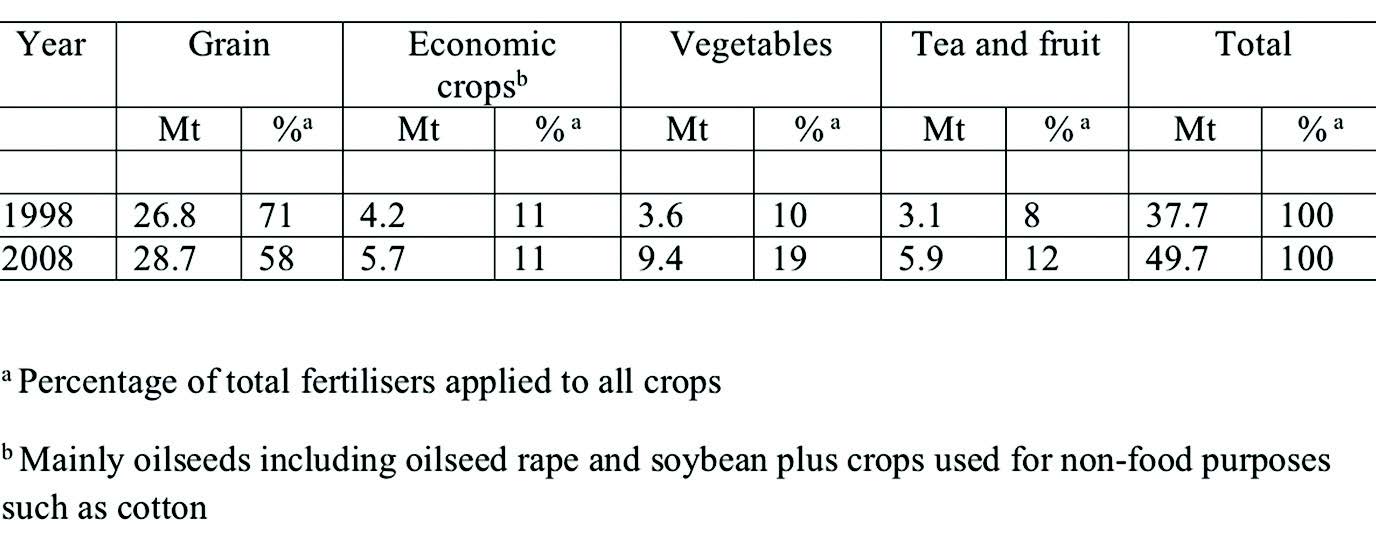
Table 1. Fertiliser used (total of N+P+K) on different crops in China: changesbetween 1998 and 2008. Values shown are quantity of fertiliser applied to eachgroup of crops and this quantity expressed as a percentage of the total used onall crops.
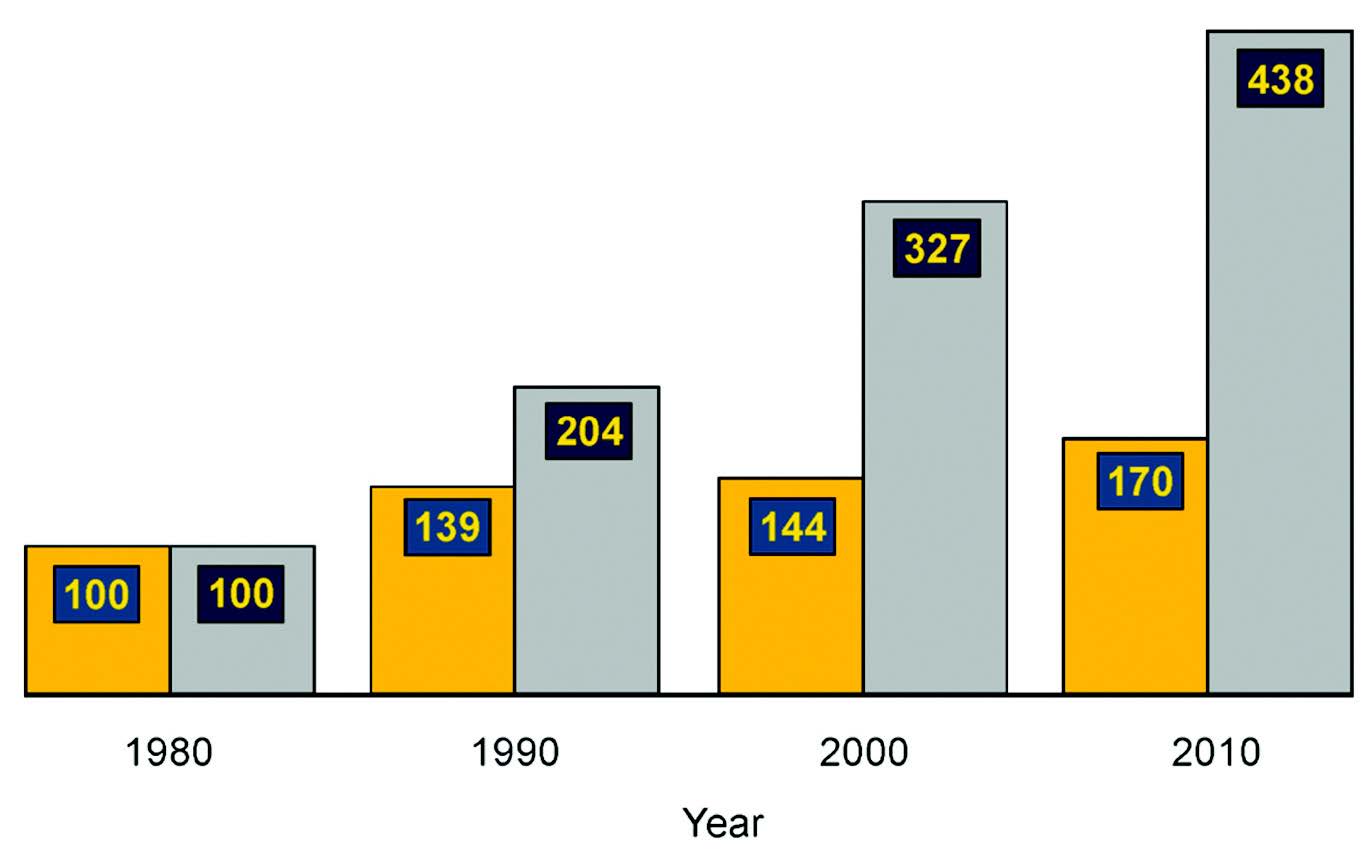
Figure 1. Changes in total fertiliser use (total of N+P+K) (grey) and grain production (total of wheat, maize and rice) (yellow) in China between 1980 and 2010. Values in 1980 set at 100.
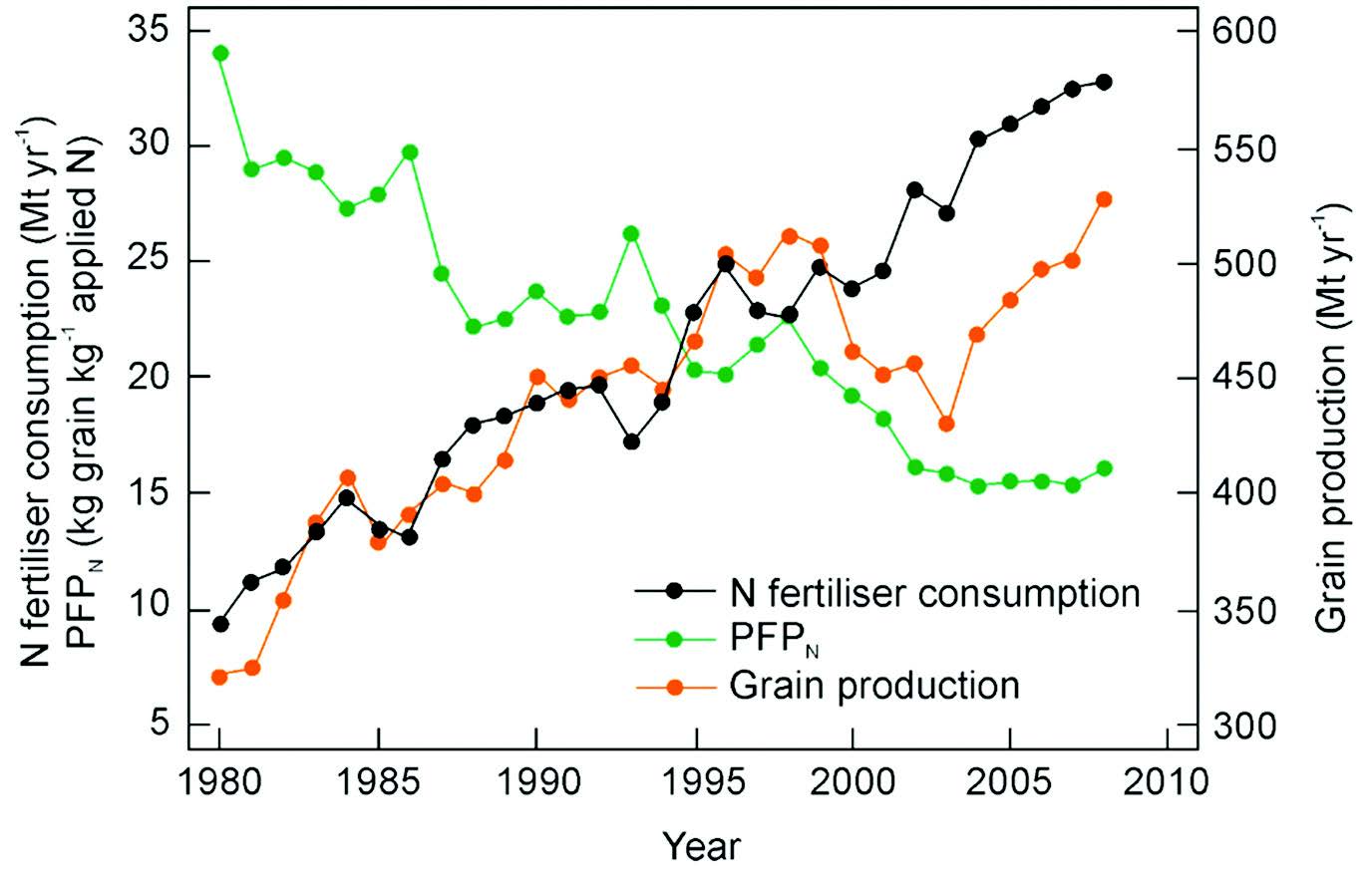
Figure 2. Changes in annual N fertiliser consumption, grain production and partial factor productivity of N (PFPN) in China between 1980 and 2008. PFPN is the ratio of grain produced to fertiliser N consumed expressed as kg grain kg-1 N.
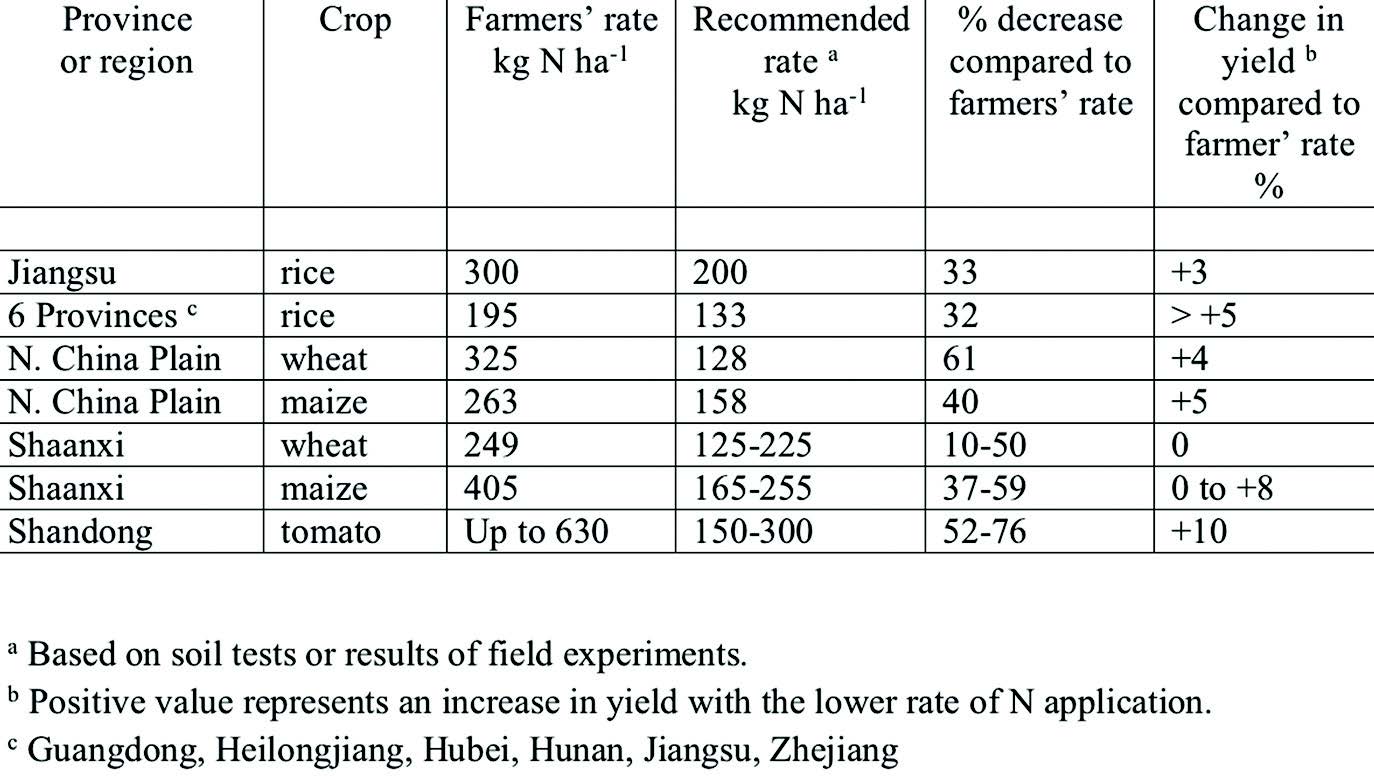
Table 2. Examples of N fertiliser over-use for various crops in different regions of China (from (7)).
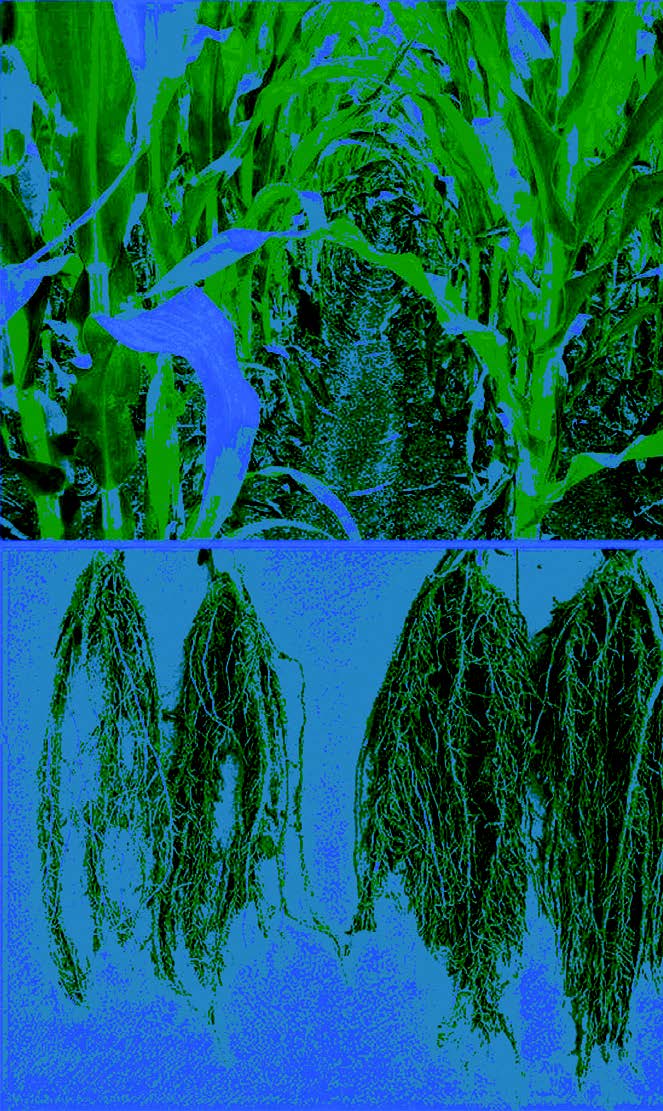
Figure 3. Effect of N fertiliser overapplicationon growth of maize roots.(a) Roots of over-fertilised plants. (b )Roots of plants given a rational rate ofN fertiliser. (Photo by C.J. Li, China Agricultural University, Beijing).
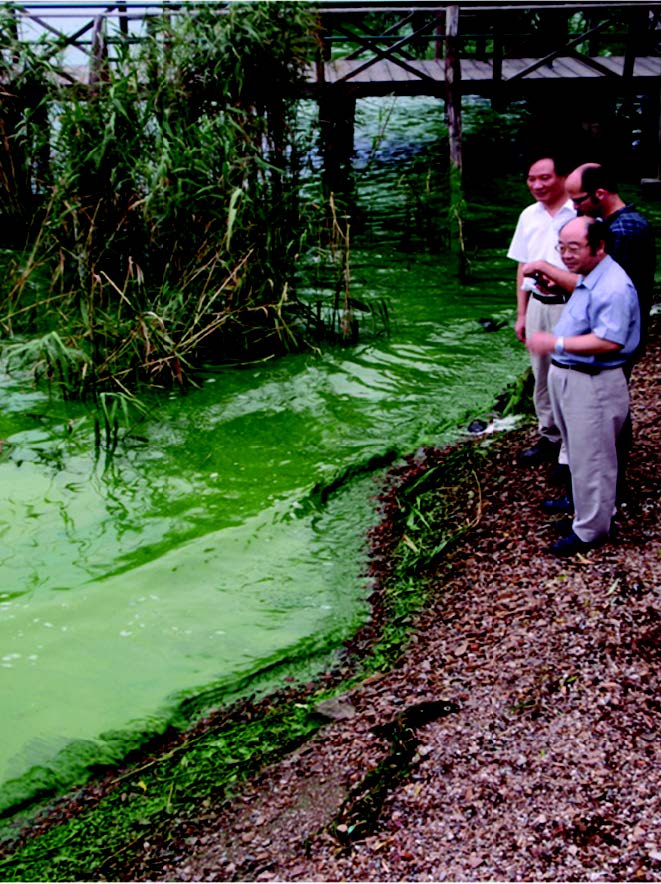
Figure 4. Lake eutophication and algal growth caused by run-off of nitrate and phosphate from agricultural land.
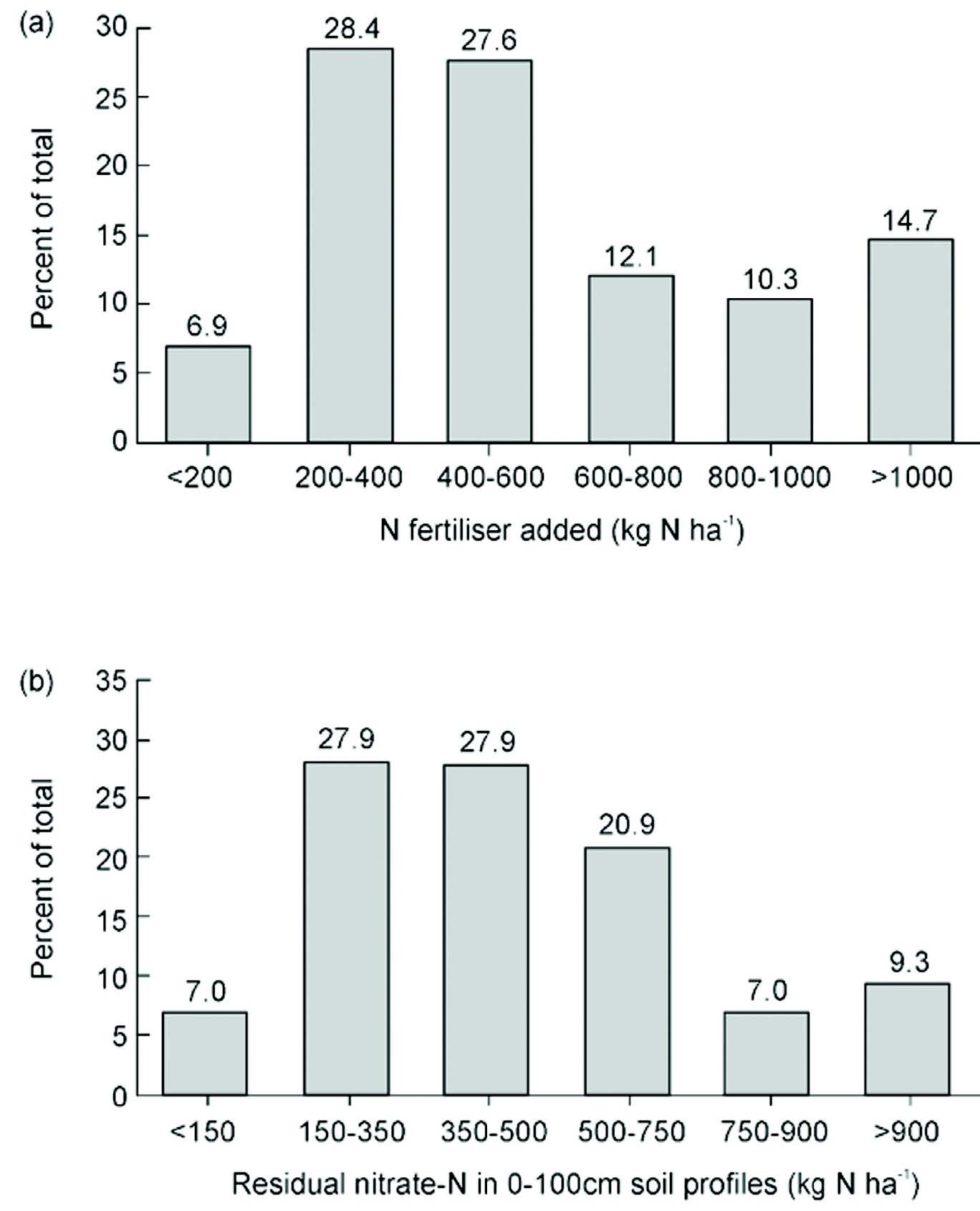
Figure 5. Results from a survey of “sunlight greenhouses” in a region near Xi’an city in northwest China. These are greenhouses used for growing a range of high-value horticultural crops under plastic, often two or three crops each year. The plastic is removed during the summer rainy period to expose the soil to rainfall so that accumulated salts are washed out. Results are mainly from greenhouses growing tomatoes, 116 being surveyed to determine rates of N fertiliser applied by the farmer and 43 being measured for nitrate accumulated in soil. Data plotted show the frequency distribution of (a) N fertiliser application rates and (b) residual nitrate (kg nitrate-N ha-1) in soil to a depth of 1m. Both are expressed as a percentage of the total number of greenhouses surveyed (From 16).
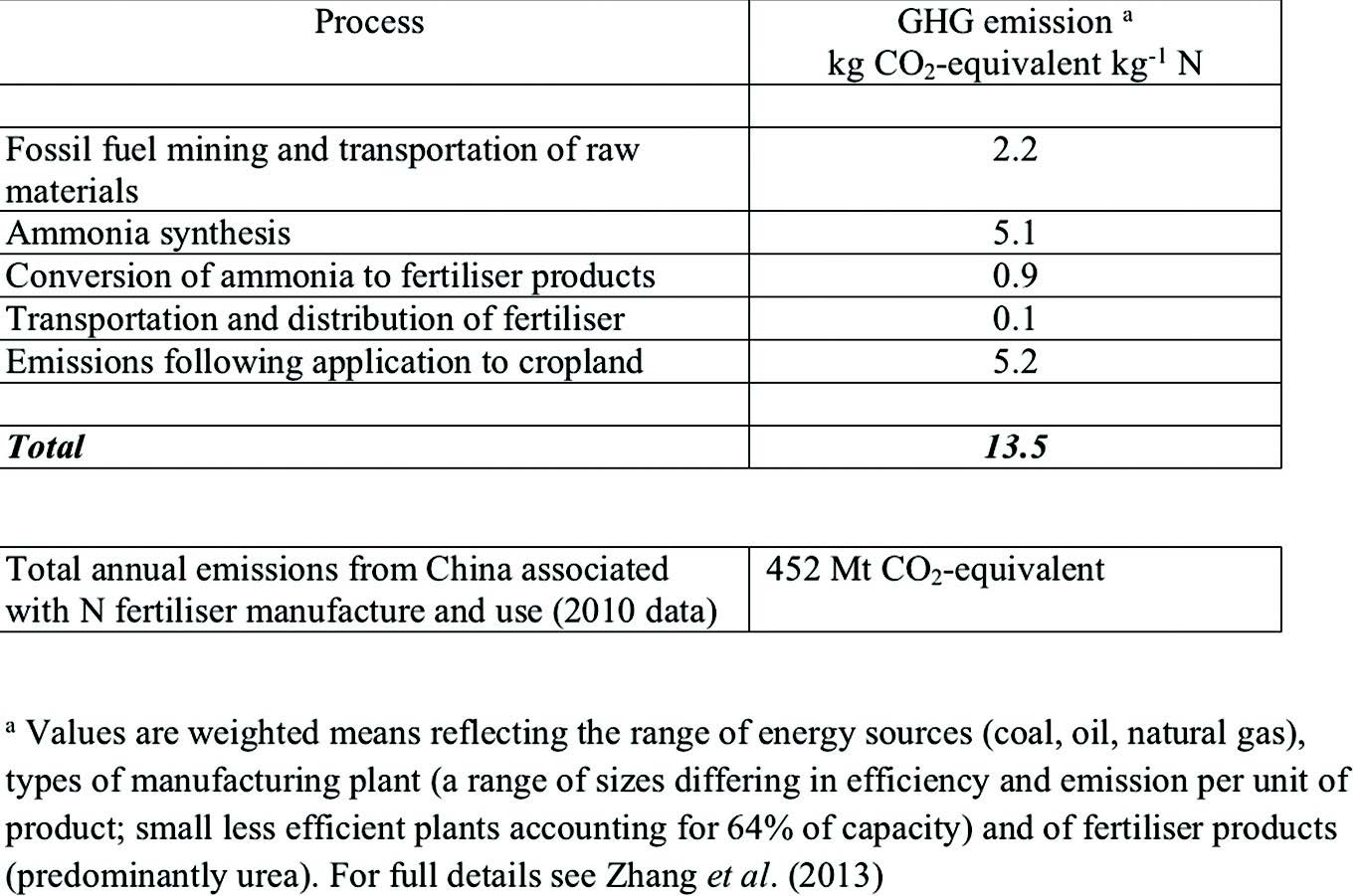
Table 3. Greenhouse gas (GHG) emissions associated with the N fertiliser chain in China including manufacture, transportation and agricultural use of N fertiliser (adapted from (26)).

Figure 6. Greenhouse gas (GHG) emissions (expressed as CO2-equivalent) associated with the manufacture and use of N fertiliser in China. Emissions shown in units of Tg CO2-equivalent (1Tg = 1012g or 1 million tonnes). Emission estimates for 2020 and 2030 are for 4 scenarios. Scenario 1: “business as usual”; N fertiliser production and use increases in line with projected population increase, no changes in manufacturing processes or agricultural practices. Scenario 2: improved manufacturing technologies. Scenario 3: improved manufacturing technologies plus controlled N use on crops. Scenario 4: improved manufacturing technologies plus reduced N use on crops using all available methods (from 26).

